Unit 7 Required Works
Grace Lewis
9 min read
Listen to this study note
Study Guide Overview
This study guide covers Unit 7 of AP Art History (Global Expansion, 600-1750 CE), focusing on the key themes of religious influence, cultural exchange, imperial power, and technological innovation. It provides in-depth analysis of 11 required works, including the Basin (Baptistère de St. Louis), Bahram Gur Fights the Karg, Ardabil Carpet, Kaaba, Jowo Rinpoche, Great Mosque of Isfahan, Court of Gayumars, Petra, Bamiyan Buddhas, Dome of the Rock, and Folio from a Qur'an. The guide also includes practice questions and exam tips covering multiple-choice, short answer, and free response questions.
#AP Art History: Unit 7 - Global Expansion (600-1750 CE) 🌍
Welcome, future art historian! This guide is your express ticket to acing Unit 7. We'll make sure you're not just memorizing facts, but truly understanding the art and its context. Let's dive in!
#🧭 Navigating Unit 7: Key Themes
Before we jump into specific works, let's get oriented. Unit 7 is all about how art and architecture spread and changed across the globe. Key themes include:
- Religious Influence: How major religions (Islam, Buddhism) shaped artistic production.
- Cultural Exchange: The impact of trade and travel on art.
- Imperial Power: How rulers used art to express their authority.
- Technological Innovation: New materials and techniques that transformed art.
Remember these themes! They're the lens through which you should analyze every artwork in this unit. AP loves to ask questions that connect these themes across different works. 💡
#🏛️ Required Works: A Deep Dive
#1. Basin (Baptistère de St. Louis) 🏺

-
Artist: Mohammed ibn al-Zain
-
Date: c. 1320-40 CE
-
Culture: Egypt or Syria
-
Material: Brass inlaid with silver and gold
-
Key Features:
- Intricate scenes of hunting, warfare, and courtly life. ⚔️
- Demonstrates the high level of metalworking skill in the Islamic world.
- Originally used for washing hands at official ceremonies, later used for baptisms of French royals.
Think of this as a 'greatest hits' of Islamic courtly life. It's not just pretty; it tells a story of power and prestige.
#2. Bahram Gur Fights the Karg 🐺

-
Date: c. 1330-40 CE
-
Culture: Iran (Persian)
-
Medium: Ink, colors, gold, and silver on paper
-
Key Features:
- From the Great Mongol Shahnama (Book of Kings), a Persian epic.
- Depicts the hero King Bahram Gur battling a mythical horned wolf (Karg).
- Shows the blending of Mongol and Persian artistic styles. 🎨
Remember Bahram Battles the Beast. Alliteration helps! Also, think of it as a medieval superhero comic.
#3. The Ardabil Carpet 🌸
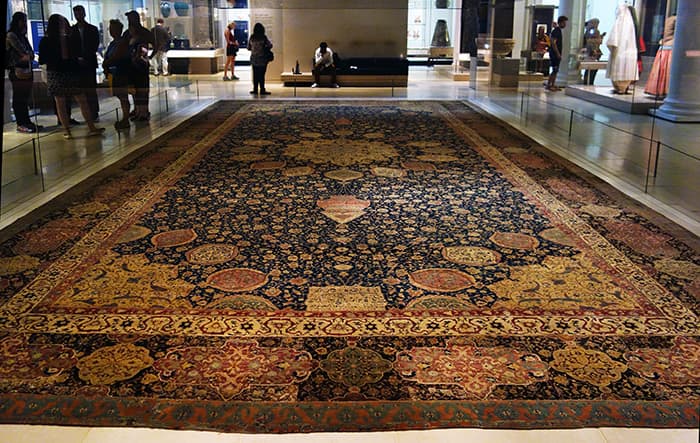

-
Date: 1539-40 CE
-
Culture: Persian (Safavid Dynasty)
-
Material: Silk warps and wefts with wool pile
-
Key Features:
- One of the world's most famous carpets, with over 25 million knots.
- Features a central medallion, intricate floral designs, and mosque lamps.
- Demonstrates the importance of carpets in Islamic art and culture.
Pay attention to the details! The lamps are not just decorative; they also symbolize light and the presence of God.
#4. The Kaaba 🕋
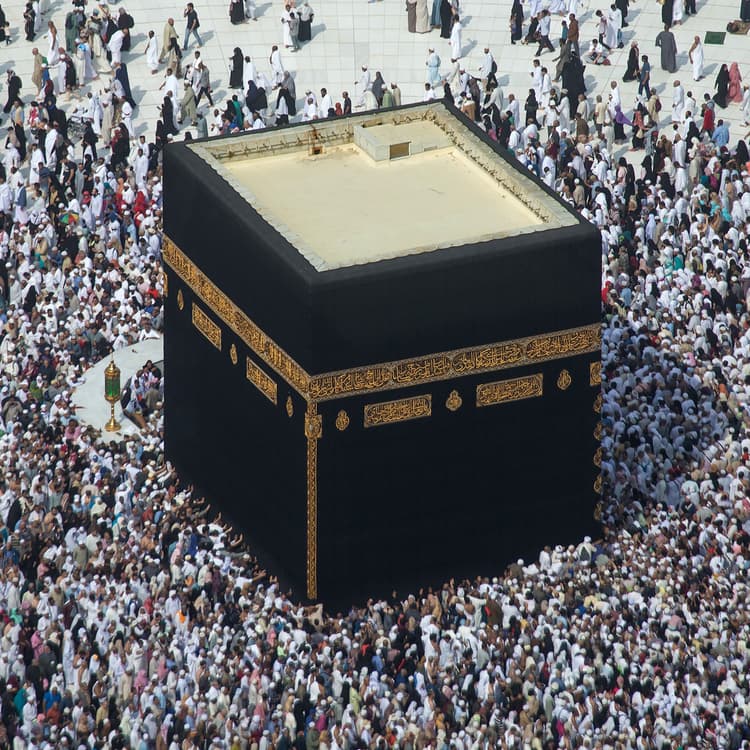
-
Date: Pre-Islamic monument, rededicated by Muhammad in 631-32 CE
-
Culture: Mecca, Saudi Arabia
-
Material: Granite masonry, covered with silk curtain (kiswah)
-
Key Features:
- The holiest site in Islam, toward which Muslims pray.
- Simple, cuboidal structure covered with a black silk cloth (kiswah) with gold calligraphy.
- Represents the unity of the Muslim community.
The Kaaba is a powerful symbol of faith and unity. It's not about the building itself, but what it represents.
#5. Jowo Rinpoche 🙏

-
Date: Brought to Tibet in 641 CE
-
Culture: Tibet (Yarlung Dynasty)
-
Material: Gilt metals with semiprecious stones, pearls, and paint
-
Key Features:
- A highly revered statue of the Buddha in Lhasa, Tibet.
- Believed to have been created during the Buddha's lifetime.
- Represents the enduring power of Buddhist faith.
This statue is considered so sacred that it's often adorned with new offerings. It's a living, breathing work of art.
#6. Great Mosque (Masjid-e Jameh) 🕌

-
Date: Built over several centuries
-
Culture: Isfahan, Iran
-
Material: Various materials including brick, tile, and stucco
-
Key Features:
- A large mosque complex with multiple courtyards, iwans, and a large dome.
- Demonstrates the evolution of Islamic architecture over time.
- Features intricate tilework, calligraphy, and geometric designs.
When discussing the Great Mosque, remember to mention the different architectural styles that were added over time. It's a great example of architectural evolution.
#7. The Court of Gayumars 👑
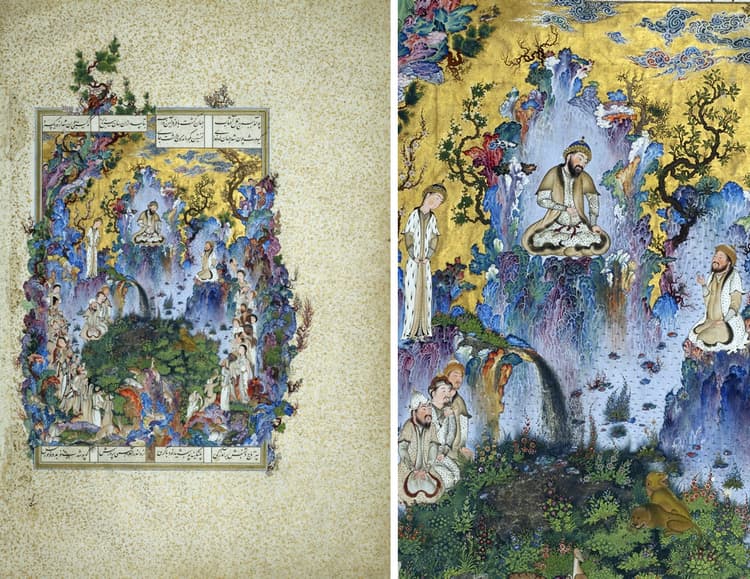
-
Artist: Sultan Muhammad
-
Date: c. 1522 CE
-
Culture: Iran (Safavid)
-
Medium: Opaque watercolor, ink, gold, silver on paper
-
Key Features:
- From the Shahnameh of Shah Tahmasp I, a Persian epic.
- Depicts the legendary first king, Gayumars, surrounded by his court.
- Shows the refined style of Persian miniature painting.
Gayumars is the first king, so remember him as the first page in the book. Think of this as the origin story of Persian kings.
#8. Petra, Jordan ⛰️

-
Date: 2nd century CE
-
Culture: Jordan
-
Material: Rock-cut architecture
-
Key Features:
- An ancient city carved into sandstone cliffs.
- Known for its elaborate rock-cut tombs and temples, especially the Treasury.
- Demonstrates the engineering and architectural skills of the Nabataean people.
Don't forget that Petra is a city, not just one building. Think of it as a whole complex with multiple structures.
#9. Buddha (Bamiyan) 🗿

-
Date: c. 6th-7th century CE
-
Culture: Bamiyan, Afghanistan
-
Material: Stone, stucco, paint
-
Key Features:
- Two colossal statues of the Buddha carved into cliffs.
- Show the influence of Gandharan style of Buddhist art.
- Tragically destroyed in 2001, highlighting the vulnerability of cultural heritage.
The destruction of the Bamiyan Buddhas is a powerful example of how art can become a target in conflicts. It's a key point for discussions about cultural preservation.
#10. Dome of the Rock 🌟
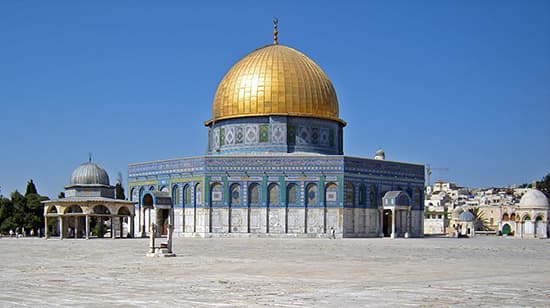
-
Date: 691-2 CE
-
Culture: Jerusalem
-
Material: Stone masonry, wooden roof, decorated with glazed ceramic tile, mosaics, and gilt aluminum and bronze dome
-
Key Features:
- An Islamic shrine built on the Temple Mount in Jerusalem.
- Features a large golden dome, intricate mosaics, and calligraphy.
- Represents the early development of Islamic architecture.
The Dome of the Rock is not a mosque! It's a shrine that marks a significant religious site for Muslims, Jews, and Christians.
#11. Folio from a Qur'an 📜
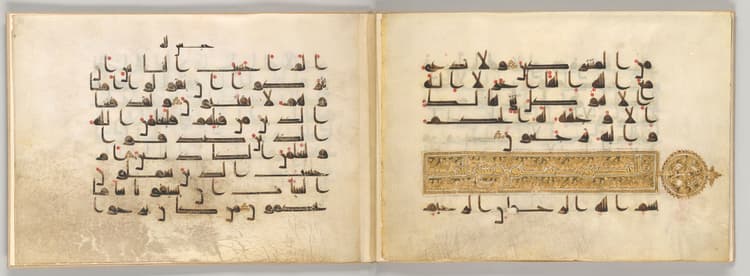
-
Date: Before 911 CE
-
Culture: Possibly Iraq
-
Material: Vellum, gold ink
-
Key Features:
- A page from an early Qur'an manuscript.
- Written in elegant calligraphy with gold ink on blue paper.
- Demonstrates the importance of calligraphy in Islamic art.
Think of this as the 'original text message' from God. The calligraphy is not just writing; it's a form of art itself.
#🎯 Final Exam Focus
Okay, deep breaths! Here's what to focus on for the exam:
- Themes: Religious influence, cultural exchange, imperial power, technological innovation.
- Connections: Be ready to compare and contrast works from different cultures and time periods.
- Context: Understand the historical, social, and religious context of each work.
- Vocabulary: Be comfortable with terms like iwan, qibla, calligraphy, and miniature.
When you see a question, don't just describe the artwork. Analyze it! What does it mean? How does it relate to the themes we discussed?
#Time Management Tips:
- MCQs: Don't linger too long on one question. If you're stuck, move on and come back later.
- FRQs: Plan your essay before you start writing. A good outline can save you time and improve your score.
- Pacing: Keep an eye on the clock. Don't get so caught up in one section that you run out of time for the others.
#Common Pitfalls:
- Describing instead of Analyzing: Don't just say what you see; explain why it matters.
- Ignoring Context: Remember the historical, social, and religious background of the art.
- Vague Language: Use specific terms and avoid generalizations.
#Practice Questions
Practice Question
Multiple Choice Questions
-
The Ardabil Carpet is best understood in the context of: (A) Roman Imperial power (B) Early Christian monasticism (C) Islamic courtly patronage (D) Buddhist meditative practices
-
Which of the following is a key characteristic of the Great Mosque of Isfahan? (A) A central plan with a large dome (B) A hypostyle hall with multiple columns (C) A series of courtyards and iwans (D) A single, towering minaret
-
The destruction of the Buddhas of Bamiyan in 2001 is best understood as an example of: (A) The fragility of cultural heritage in times of conflict (B) The natural process of decay and erosion (C) The changing styles of Buddhist art (D) The triumph of secularism over religious belief
Short Answer Question
Briefly describe the religious significance of the Kaaba and its importance to the Islamic faith.
Free Response Question
Analyze how cultural exchange and religious influence are reflected in two of the following works:
- Basin (Baptistère de St. Louis)
- The Ardabil Carpet
- Jowo Rinpoche
- Dome of the Rock
FRQ Scoring Breakdown:
- Thesis (1 point): A clear, historically defensible thesis that addresses the prompt.
- Evidence (2 points per work, 4 total): Specific and relevant evidence about each work of art, including materials, style, and context.
- Analysis (2 points per work, 4 total): Explanation of how the evidence supports the thesis, including analysis of cultural exchange and religious influence.
- Synthesis (1 point): Demonstrates an understanding of the broader themes and connections across the works of art.
You've got this! Go ace that exam! 💪
Continue your learning journey

How are we doing?
Give us your feedback and let us know how we can improve





